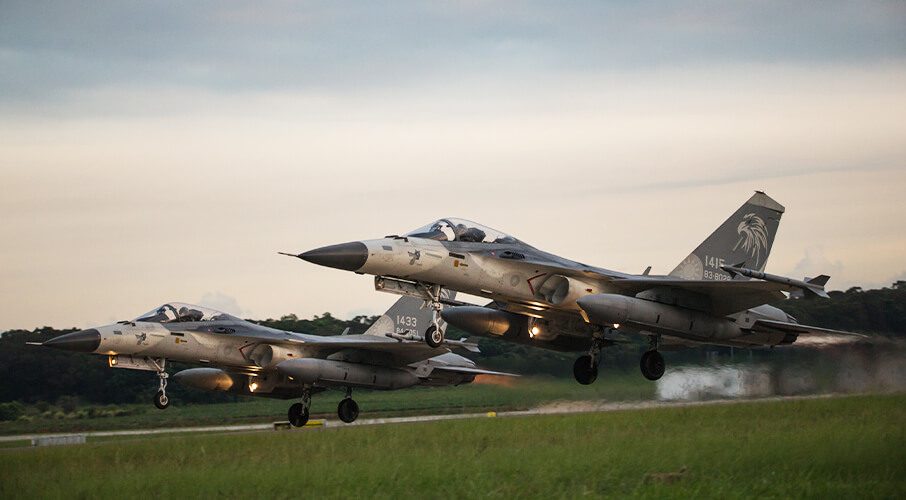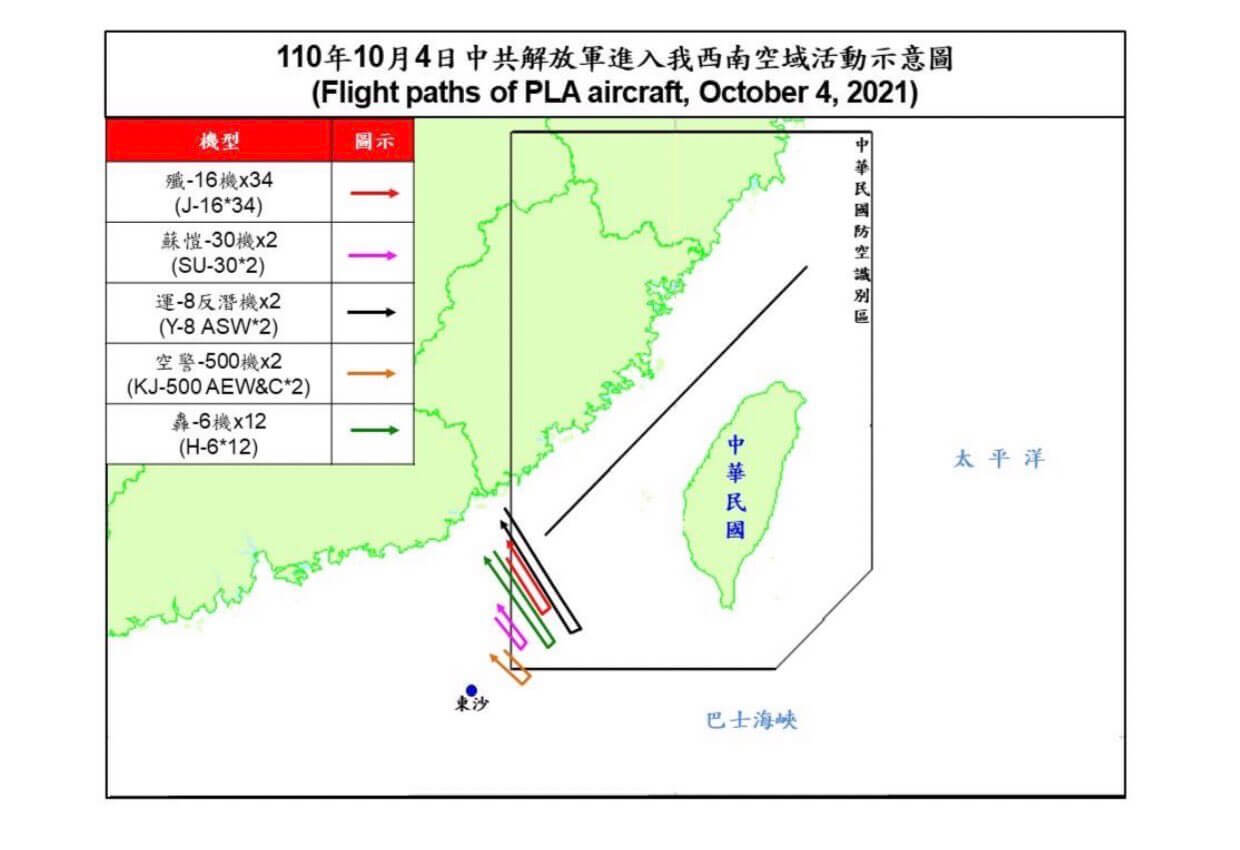
Continued US support for Taiwan, and increasingly that of other members of the international community, remains indispensable as a means to deter Chinese aggression, writes J. Michael Cole.
By J. Michael Cole, October 5, 2021
In the past five days since October 1, a total of 150 aircraft from the People’s Liberation Army’s Air Force (PLAAF) and Navy (PLAN) have intruded into Taiwan’s southwestern Air Defense Identification Zone (ADIZ), including a record 56 on October 4 alone. This major uptick in military activity has garnered the world’s attention and prompted much speculation about what may be driving Beijing to escalate at this particular moment, and what it seeks to achieve by doing so.
And escalate it has. For the whole of 2020, Taiwan reported a total of 380 Chinese incursions into its defence zone; that number has already exceeded 600 for 2021. As of this writing, only one intrusion was reported on October 5, a reduction that follows a stern warning to Beijing by senior US officials working behind the scenes.
Escalation
 PLAAF/PLAN activity in the area has been building up for over the past year and a half, with spikes usually surrounding geopolitical developments involving Taiwan. On some occasions, Beijing authorities have drawn a direct link between such intrusions and moves by Taiwan or its partners, such as Taiwan’s declaration that it was officially seeking admission into the Comprehensive and Progressive Agreement for Trans-Pacific Partnership (CPTPP) or signs of rapprochement between Taipei and Washington or Tokyo. On other occasions, Beijing did not specifically mention why a number of PLA aircraft had intruded into Taiwan’s ADIZ, leaving the press to speculate and search for some connection.
PLAAF/PLAN activity in the area has been building up for over the past year and a half, with spikes usually surrounding geopolitical developments involving Taiwan. On some occasions, Beijing authorities have drawn a direct link between such intrusions and moves by Taiwan or its partners, such as Taiwan’s declaration that it was officially seeking admission into the Comprehensive and Progressive Agreement for Trans-Pacific Partnership (CPTPP) or signs of rapprochement between Taipei and Washington or Tokyo. On other occasions, Beijing did not specifically mention why a number of PLA aircraft had intruded into Taiwan’s ADIZ, leaving the press to speculate and search for some connection.
The PLAAF/PLAN incursions into Taiwan’s ADIZ have all occurred in international airspace in the Bashi Channel between Taiwan and the Philippines. Moreover, the transits did not intrude into Taiwan’s airspace, as various media and commentators have erroneously claimed.
Although Taiwan’s ADIZ overlaps with Chinese territory, the daily reports on the intrusions released by Taiwan’s Ministry of National Defense (MND) only mention incursions that occur on the Taiwan side of the Taiwan Strait – if one extends the tacit “median line” that separates the Strait to the air corridor where the PLAAF/PLAN activity has occurred. However, on a few occasions, PLA aircraft have crossed the “median line,” which represent moves that are much more threatening to Taiwan’s security than the ordinary transits that have made the news recently.
The PLA aircraft involved in the intrusions since 2020 include J-11, J-16, and Su-30 combat aircraft, Y-8 anti-submarine/electronic warfare aircraft, KJ-500 airborne early warning and control aircraft, as well as H-6K long-range bombers.
A much more troubling development are the handful of occasions when PLAAF/PLAN aircraft first intruded into Taiwan’s southwestern ADIZ and then made a sharp turn leftwards into the rear (east) side of Taiwan’s ADIZ. Such manoeuvres, as occurred on October 1 and June 15 (when 28 aircraft entered Taiwan’s ADIZ), are much less innocent and represent a threat of encirclement against Taiwan. In other words, these intrusions present Taiwan’s air defence systems with a new vector of attack from China, which has traditionally been expected to come from Taiwan’s western side across the Taiwan Strait.
The ADIZ intrusions serve multiple purposes, including (1) training to familiarize PLA pilots with operations at sea and at night; (2) intelligence collection against Taiwan based on the latter’s response; (3) overstretch the Taiwanese military by forcing it to respond to every intrusion; (4) signal discontent aimed at Taipei and its partners following developments that favor Taiwan; (5) psychological warfare against Taiwan through coercion, conditioning, etc.; and (6) salami-slicing, whereby a gradual increase in PLA activity near Taiwan becomes a new norm, thus accentuating the element of surprise should Beijing eventually decide to use force against Taiwan.
Although most reporting and analysis has focused on the Taiwan elements to the PLA intrusions, it is also important to point out that the manoeuvres are also in response to the activities of regional powers, such as US freedom of navigation naval patrols, surveillance aircraft and other military activities in or near the South China Sea, a more proactive and vocal Japan in regional affairs, inclusion of Taiwan in statements by NATO, the G7, and the EU, and developments suggesting the formation of a regional security alliance (e.g., AUKUS, Quad), which China will likely regard as the possible beginning of containment.
As such, PLAAF/PLAN intrusions into Taiwan’s ADIZ serves both as a means to signal discontent and to demonstrate to the US and the international community that it will not be deterred from flexing its muscles in what it regards as its backyard. The huge spike seen on October 4 may in fact have been in response to a statement by the US Department of State on earlier escalation by Beijing.
Finally, the incursions also provide the leadership in Beijing with an instrument by which to demonstrate to its own people—and to more hawkish elements within the PLA and the Chinese Communist Party (CCP)—that it has the situation under control and is not backtracking amid intensifying pushback by the international community. On some occasions, the CCP was severely criticized and ridiculed by its own ultranationalist wing (the “little pinks”) when it failed to respond to “provocations” over Taiwan, such as when a US Air Force C-17 Globemaster III landed at Taipei International Airport (Songshan) in June. Having set “red lines” over international engagement with Taiwan, Beijing needs an outlet to express its anger in response. The ADIZ transits are a relatively low-cost, low-risk tool to accomplish this type of signalling.
A prelude to war?
The recent military activity near Taiwan has fuelled much speculation that this may be as a prelude to an attack against Taiwan. Certainly, as indicated in points 2 and 6 above, the frequent intrusions by PLAAF/PLAN aircraft is helping pilots familiarize themselves with the environment surrounding Taiwan and providing the training they would need to conduct operations in daytime and nighttime. Still, the activity so far does not provide clear evidence that Beijing has decided to match capabilities with intent.
One school of thought among China watchers is that all this activity is little more than bluster, signalling, and psychological warfare by Beijing. In this view, decision-makers at Zhongnanhai are not ready, or foolish enough, to gamble China’s future on military adventurism – especially if such actions resulted in a military confrontation with the US. In other words, it is expected that Beijing continues to act rationally, by weighing the pros and cons of its actions.
Notably, despite the repeated threats by Beijing over many decades, China has so far not launched an attack against Taiwan, which analysts in this camp interpret as evidence that deterrence and rationality prevailed over a desire to use the military option and that they will continue to do so. Of course, one critique of this argument could be that during that period Beijing had the intent but lacked the capabilities.
However, Beijing could confront situations that may lead it to adopt strategies which, from the outside, may appear irrational. For example, instability in China of a magnitude that threatens the survival of Xi Jinping and/or the CCP could compel the regime to externalize the crisis and thereby deflect domestic criticism. This type of external distraction needs an identifiable enemy, which in this case could be “Taiwanese independence.” Such a move would be a very dangerous gamble, especially as it would risk promoting a US intervention. But it is not entirely impossible that the regime could resort to such an option if its survival depended on it.
Another scenario is when Beijing concludes that Taiwan is slipping away, either by a declaration of de jure independence or, short of this, by international developments that reinforce Taiwan’s statehood and close the door to “peaceful unification.” So far Beijing continues to behave as if its Taiwan strategy has been bearing fruit, and it has used heavy propaganda domestically to convince the Chinese people that things are moving in the direction set by Beijing. If the day come when it is no longer possible to sell this lie, Beijing will face a difficult choice: admit it was wrong (highly unlikely) or, having painted itself into a corner through years of propaganda and deceit, and with its reputation at stake, argue that developments leave it no choice to take defensive action against Taiwan to arrest a further drift toward independence.
Deterrence is key
Under either scenarios, Beijing has a higher likelihood of using force if it concluded that Taiwan would be alone facing the Chinese military onslaught and that an invasion of Taiwan could be accomplished relatively quickly and with relatively low casualties on the Chinese side. That is why continued US support for Taiwan – and increasingly that of other members of the international community – remains indispensable as a means to deter Chinese aggression. The greater the deterrence (military, economic, political) against this type of behaviour, the likelier it is that decision-makers in Beijing will continue to think and act rationally on the matter of Taiwan.
J. Michael Cole is a Taipei-based senior fellow with the Macdonald-Laurier Institute and the Global Taiwan Institute in Washington, DC. He is a former analyst with the Canadian Security Intelligence Service in Ottawa.





